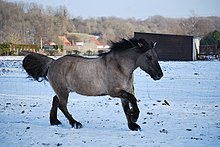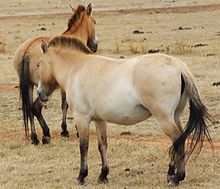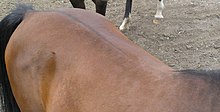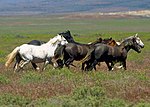Dun gene



The dun gene is a dilution gene that affects both red and black pigments in the coat color of a horse. The dun gene has the ability to affect the appearance of all black, bay, or chestnut-based horses by lightening the base body coat and suppressing the underlying base color to the mane, tail, legs, and primitive markings.
The classic dun is a gray-gold or tan, characterized by a body color ranging from sandy yellow to reddish brown. A dun horse always has a dark stripe down the middle of its back, a tail and mane darker than the body coat, and usually darker face and legs. Other duns may appear a light yellowish shade, or a steel gray, depending on the underlying coat color genetics. Manes, tails, primitive markings, and other dark areas are usually the shade of the undiluted base coat color.
The dun allele is a simple dominant, so the phenotype of a horse with either one copy or two copies of the gene is dun. It has a stronger effect than other dilution genes, such as the silver dapple gene, which acts only on black-based coats, or the cream gene, an incomplete dominant which must be homozygous to be fully expressed, and when heterozygous is only visible on bay and chestnut coats, and then to a lesser degree.[1]
The dun gene also is characterized by primitive markings, which are darker than the body color. Primitive markings include:
- Dorsal stripe (stripe down the center of the back, along the spine), seen almost universally on all duns
- Horizontal striping on the back of forelegs, common on most duns, although at times, rather faint
- Shoulder blade stripe, the least commonly seen of the primitive markings
Dorsal striping does not guarantee the horse carries the dun gene. A countershading gene can also produce faint dorsal striping, even in breeds such as the Arabian horse or the Thoroughbred, where the dun gene is not known to be carried in the gene pool. A primary characteristic of the dun gene is the dorsal stripe, and most duns also have visual leg striping. The shoulder stripes are less common and often fainter, but usually visible on horses with a short summer coat.[1]
Taxonomic distribution

The dun coat color is thought to be a primitive trait in the horse. This is because equines appearing in prehistoric cave paintings are dun, and because several closely related species in the genus Equus are known to have been dun. These species include both subspecies of Equus ferus (the extinct tarpan and the extant, but endangered Przewalski's horse), the extinct Equus lambei, and the extant onager and kiang.
Shades of dun

The dun gene has a stronger dilution effect on the body than the mane, tail, legs, and primitive markings, so lightens the body coat more. This explains why points on a dun are a shade darker than the coat, or in the case of a "classic" dun, the mane, tail, and legs often are black or only slightly diluted.
- Dun, also called bay dun, classic dun or zebra dun, the most common type of dun, has a tan or gold body with black mane, tail, and primitive markings. Genetically, the horse has an underlying bay coat color, acted upon by the dun gene.
- Red dun, also called claybank or fox dun, horses do not have black points, as there is no black on the horse to be affected. Instead, the points and primitive markings are a darker shade of red than the coat. Genetically, the horse has an underlying chestnut coat color, acted upon by the dun gene.
- Grullo or grulla, also called blue dun or "mouse" dun, is a smoky, bluish, to mouse-brown color and can vary from light to dark. They consistently have black points and they often have a dark or black head, which is an identifying characteristic of this color. The primitive markings usually are all black. Genetically, the horse has an underlying black coat color, acted upon by the dun gene. Unlike a blue roan, there are no intermingled black and white hairs, and unlike a true gray, which also intermingles light and dark hairs, the color does not change to a lighter shade as the horse ages. With a dun, the hair color itself is one solid shade.
Dun mimics


Since the dun gene, when on a "bay dun" horse, can closely resemble buckskin, in that both colors feature a light-colored coat with a dark mane and tail, classic duns frequently are confused with buckskins. The difference between these two colors is the dun as a tan color, somewhat duller than the more cream or gold buckskin, and duns also possess primitive markings. Some buckskins do show countershading, but it is not related to the primitive markings of dun factor horses.
Genetically, a bay dun is a bay horse with the dun gene that causes the lighter coat color and the primitive markings. A buckskin is bay horse with the addition of the cream gene, causing the coat color to be diluted from red to gold, often without primitive markings.
A red dun may also be confused with a perlino, which is genetically a bay horse with two copies of the cream gene, which creates a horse with a cream-colored body but a reddish mane and tail. However, perlinos usually are significantly lighter than a red dun and have blue eyes.
To further confuse matters, it is possible for a horse to carry both dun and cream dilution genes; such horses with golden buckskin coloring and a complete set of primitive markings are referred to as a "buckskin dun" or a "dunskin". In the Fjord horse, duns that also carry the creme dilution are called uls dun or white dun (ulsblakk) and yellow dun (gulblakk) by their respective coat colors. On such horses, the light-shaded primitive markings are most noticeable during the summer months, when the winter hair sheds.
Countershading is a usually a darker shade of the body color rather than the near-black of primitive markings on bay duns, but it may be harder to differentiate between countershading and a dorsal stripe on light-colored horses such as red duns. In such cases, pedigree analysis, DNA testing, studying possible offspring, and the presence of other primitive markings are used to determine whether a horse is a dun.
Breeding and the dun gene

Genetic analysis and DNA sequencing results published in 2015 link dun color to the T-box 3 (TBX3) transcription factor. When active, it creates dun coloring, including the primitive markings, and when recessive, a horse is not dun. In humans and lab mice, TBX3 affects affect bones, breast tissue, and cardiac conduction; inactivation of the TBX3 gene affects a protein function and is linked to ulnar–mammary syndrome. The study demonstrated that TBX3 also affects skin and hair. In horses, the protein inactivation does not occur; TBX3 only affects where and how the gene is expressed in the hair. Where diluted color exists, the color is not uniform, but rather is more intense on the outward-facing side of the hair shaft and lighter underneath. In the darker areas, where the primitive markings occur, the hair shaft is of uniform color. This phenomenon is new to science and has not been observed in other animals. The 2015 study also noted that there were two forms of non-dun color, labeled non-dun1 and non-dun2, caused by different mutations. Non-dun1 horses have some primitive markings, non-dun2 horses do not. It is thought that non-dun2 genetic mutation occurred after domestication, whereas dun and non-dun1 predate domestication. Ancient DNA from a horse that lived about 43,000 years ago, long before horses were domesticated, carried both dun and non-dun1 genes. It is hypothesized that TBX3 may also be linked to striping in zebras.[2]
The three primary dun varieties usually occur in proportion to the occurrence of the corresponding base coat colors in any particular breed. They are created by the following combinations of the dun gene acting upon an underlying base coat color.
- Red (chestnut) base + dun gene = red dun
- Black base + dun gene = blue dun, also called mouse dun or grullo/grulla
- Bay (black base + agouti gene) + dun gene = classic dun, sometimes called "bay dun" or "zebra dun".
Other variations result from the interplay of additional genes:
- Chestnut + dun + cream gene (single copy) = "dunalino" or "palomino dun"
- Bay + dun + cream gene (single copy) = "dunskin" or "buckskin dun"
A single copy of the cream gene on a black base coat does not significantly lighten black hair, though it may have a subtle effect,[3] and thus a single copy generally has no visible effect on a grullo, either. Conversely, double copies of the cream gene create very light-colored horses (cremello, perlino, and smoky cream). Thus, if a horse with two cream dilution alleles also carries the dun gene, it also will be cream-colored, with primitive markings not visible to any significant degree.
The Fjord horse breed, which is predominantly dun, uses unique Norwegian-based terminology to distinguish between the different shades of dun horses. "Brown dun," or brunnblakk is a zebra dun, rødblakk is a red dun, grå - literally "gray" - is a grullo, buckskin duns are called ulsblakk or white dun, and a dunalino is called a "yellow dun" or gulblakk. A cremello, perlino or smoky cream is called "white" or kvit.[4]
See also
References
- ^ a b "Dun Zygosity Test." Veterinary Genetics Lab, University of California, Davis. Web page accessed December 4, 2009
- ^ Waara, Anneli (December 21, 2015). "Genetics of camouflage and the Dun pattern in horses". SciLifeLab, Uppsala University. Retrieved June 26, 2016.
- ^ Cream - Horse Coat Color
- ^ Sponenberg, Phillip. "Color in Fjord Horses". Norwegian Fjord Horse Registry. Retrieved January 20, 2010.
- "Introduction to Coat Color Genetics" from Veterinary Genetics Laboratory, School of Veterinary Medicine, University of California, Davis. Web Site accessed January 12, 2008
- Genetic mutation that causes Dun coat color in horses
- Dun Zygosity test from Veterinary Genetics Laboratory, School of Veterinary Medicine, University of California, Davis. Web Site accessed January 12, 2008
- Dun Horse Shades: Grullo, Red Dun, Bay Dun & Photos
- Dun Factors: Dorsal Stripe, Leg Barring, etc.

